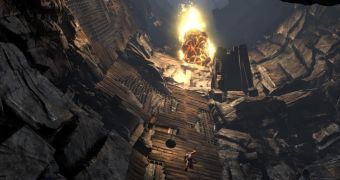There are two rather complex puzzles in the last God of War 3, one centered around the Labyrinth, which Daedalus created to protect Pandora for Zeus and another centered around powered boxes and Daedalus' obsession with seeing his son Icarus again. Both of them posed problems because they required looking at a bigger picture and how pieces need to align themselves to allow for progression.
The chase after Hera is especially interesting. The 3D world can be turned into one that has only two dimensions, allowing for elements that seemed initially unconnected to be linked with one another to progress.
At one point, the whole scenario even involves dragging around the body of Hera, the actual wife of Zeus, in order to use her as a weight in the final sequence of the puzzle. It's quite engaging and can take a lot of time if players, like me, have trouble in getting their head around the main concept of 3D turning into 2D.
The Labyrinth where Daedalus resides is even more intriguing. It actually kind of abandons the mythical underpinnings of God of War 3 to turn into something out of a steampunk adventure with a liquid fire provided by Hades and an ice storm used to power huge mechanical cubes that need to be aligned into position for Kratos to get inside them. Once there, God of War 3 takes quite a bit of cues from the series of horror movies called The Cube, made between 1997 and 2004.
Sony Santa Monica puts a unique twist on the concept by throwing in quite a bit of enemies into the cube spaces with the player, alongside an array of deadly traps that can only be avoided through ingenious use of a harpy. It's a very engaging section of the game but, believe me, one bad move and you'll curse the Gods as you are dumped back to the beginning of the sequence.

 14 DAY TRIAL //
14 DAY TRIAL //